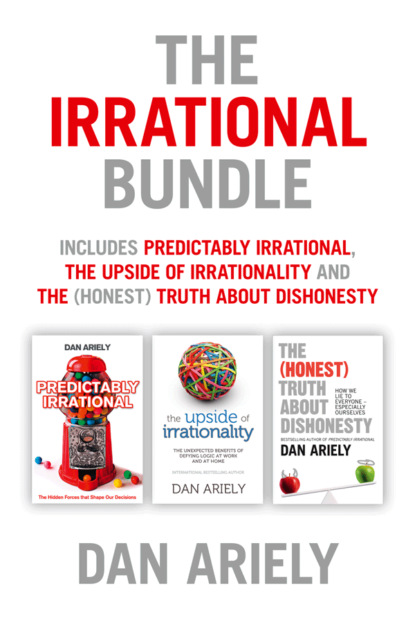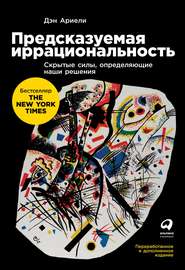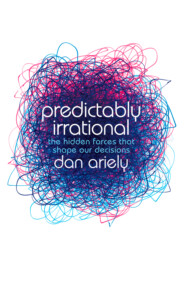По всем вопросам обращайтесь на: info@litportal.ru
(©) 2003-2024.
✖
The Irrational Bundle
Автор
Год написания книги
2018
Настройки чтения
Размер шрифта
Высота строк
Поля
Some people at Ford thought this was a great idea, but at first the Ford engineers fought it. They had to be convinced that, yes, drivers could go 9,000 miles without an oil change—but that 5,000 miles would align the oil change with everything else that needed to be done. They had to be convinced that a Mustang and a F-250 Super Duty truck, despite their technological differences, could be put on the same maintenance schedule. They had to be convinced that rebundling their 18,000 maintenance options into three easily scheduled service events—making maintenance as easy as ordering a Value Meal at McDonald’s—was not bad engineering, but good customer service (not to mention good business). The winning argument, in fact, was that it is better to have consumers service their vehicles at somewhat compromised intervals than not to service them at all!
In the end, it happened: Ford joined Honda in bundling its services. Procrastination stopped. Ford’s service bay, which had been 40 percent vacant, filled up. The dealers made money, and in just three years Ford matched Honda’s success in the service bay.
So couldn’t we make comprehensive physicals and tests as simple—and, with the addition of self-imposed financial penalties (or better, a “parental” voice), bring the quality of our health way up and at the same time make the overall costs significantly less? The lesson to learn from Ford’s experience is that bundling our medical tests (and procedures) so that people remember to do them is far smarter than adhering to an erratic series of health commands that people are unwilling to follow. And so the big question: can we shape America’s medical morass and make it as easy as ordering a Happy Meal? Thoreau wrote, “Simplify! Simplify!” And, indeed, simplification is one mark of real genius.
Savings
We could order people to stop spending, as an Orwellian edict. This would be similar to the case of my third group of students, for whom the deadline was dictated by me. But are there cleverer ways to get people to monitor their own spending? A few years ago, for instance, I heard about the “ice glass” method for reducing credit card spending. It’s a home remedy for impulsive spending. You put your credit card into a glass of water and put the glass in the freezer. Then, when you impulsively decide to make a purchase, you must first wait for the ice to thaw before extracting the card. By then, your compulsion to purchase has subsided. (You can’t just put the card in the microwave, of course, because then you’d destroy the magnetic strip.)
But here’s another approach that is arguably better, and certainly more up-to-date. John Leland wrote a very interesting article in the New York Times in which he described a growing trend of self-shame: “When a woman who calls herself Tricia discovered last week that she owed $22,302 on her credit cards, she could not wait to spread the news. Tricia, 29, does not talk to her family or friends about her finances, and says she is ashamed of her personal debt. Yet from the laundry room of her home in northern Michigan, Tricia does something that would have been unthinkable—and impossible—a generation ago: She goes online and posts intimate details of her financial life, including her net worth (now a negative $38,691), the balance and finance charges on her credit cards, and the amount of debt she has paid down ($15,312) since starting the blog about her debt last year.”
It is also clear that Tricia’s blog is part of a larger trend. Apparently, there are dozens of Web sites (maybe there are thousands by now) devoted to the same kind of debt blogging (from “Poorer than You” poorerthanyou.com and “We’re in Debt” wereindebt.com to “Make Love Not Debt” makelovenotdebt.com and Tricia’s Web page: bloggingawaydebt.com). Leland noted, “Consumers are asking others to help themselves develop self-control because so many companies are not showing any restraint.”
Blogging about overspending is important and useful, but as we saw in the last chapter, on emotions, what we truly need is a method to curb our consumption at the moment of temptation, rather than a way to complain about it after the fact.
What could we do? Could we create something that replicated the conditions of Gaurav’s class, with some freedom of choice but built-in boundaries as well? I began to imagine a credit card of a different kind—a self-control credit card that would let people restrict their own spending behavior. The users could decide in advance how much money they wanted to spend in each category, in every store, and in every time frame. For instance, users could limit their spending on coffee to $20 every week, and their spending on clothing to $600 every six months. Cardholders could fix their limit for groceries at $200 a week and their entertainment spending at $60 a month, and not allow any spending on candy between two and five PM. What would happen if they surpassed the limit? The cardholders would select their penalties. For instance, they could make the card get rejected; or they could tax themselves and transfer the tax to Habitat for Humanity, a friend, or long-term savings. This system could also implement the “ice glass” method as a cooling-off period for large items; and it could even automatically trigger an e-mail to your spouse, your mother, or a friend:
Dear Sumi,
This e-mail is to draw your attention to the fact that your husband, Dan Ariely, who is generally an upright citizen, has exceeded his spending limit on chocolate of $50 per month by $73.25.
With best wishes,
The self-control credit card team
Now this may sound like a pipe dream, but it isn’t. Think about the potential of Smart Cards (thin, palm-size cards that carry impressive computational powers), which are beginning to fill the market. These cards offer the possibility of being customized to each individual’s credit needs and helping people manage their credit wisely. Why couldn’t a card, for instance, have a spending “governor” (like the governors that limit the top speed on engines) to limit monetary transactions in particular conditions? Why couldn’t they have the financial equivalent of a time-release pill, so that consumers could program their cards to dispense their credit to help them behave as they hope they would?
A FEW YEARS ago I was so convinced that a “self-control” credit card was a good idea that I asked for a meeting with one of the major banks. To my delight, this venerable bank responded, and suggested that I come to its corporate headquarters in New York.
I arrived in New York a few weeks later, and after a brief delay at the reception desk, was led into a modern conference room. Peering through the plate glass from on high, I could look down on Manhattan’s financial district and a stream of yellow cabs pushing through the rain. Within a few minutes the room had filled with half a dozen high-powered banking executives, including the head of the bank’s credit card division.
I began by describing how procrastination causes everyone problems. In the realm of personal finance, I said, it causes us to neglect our savings—while the temptation of easy credit fills our closets with goods that we really don’t need. It didn’t take long before I saw that I was striking a very personal chord with each of them.
Then I began to describe how Americans have fallen into a terrible dependence on credit cards, how the debt is eating them alive, and how they are struggling to find their way out of this predicament. America’s seniors are one of the hardest-hit groups. In fact, from 1992 to 2004 the rate of debt of Americans age 55 and over rose faster than that of any other group. Some of them were even using credit cards to fill the gaps in their Medicare. Others were at risk of losing their homes.
I began to feel like George Bailey begging for loan forgiveness in It’s a Wonderful Life. The executives began to speak up. Most of them had stories of relatives, spouses, and friends (not themselves, of course) who had had problems with credit debt. We talked it over.
Now the ground was ready and I started describing the self-control credit card idea as a way to help consumers spend less and save more. At first I think the bankers were a bit stunned. I was suggesting that they help consumers control their spending. Did I realize that the bankers and credit card companies made $17 billion a year in interest from these cards? Hello? They should give that up?
Well, I wasn’t that naive. I explained to the bankers that there was a great business proposition behind the idea of a self-control card. “Look,” I said, “the credit card business is cutthroat. You send out six billion direct-mail pieces a year, and all the card offers are about the same.” Reluctantly, they agreed. “But suppose one credit card company stepped out of the pack,” I continued, “and identified itself as a good guy—as an advocate for the credit-crunched consumer? Suppose one company had the guts to offer a card that would actually help consumers control their credit, and better still, divert some of their money into long-term savings?” I glanced around the room. “My bet is that thousands of consumers would cut up their other credit cards—and sign up with you!”
A wave of excitement crossed the room. The bankers nodded their heads and chatted to one another. It was revolutionary! Soon thereafter we all departed. They shook my hand warmly and assured me that we would be talking again, soon.
Well, they never called me back. (It might have been that they were worried about losing the $17 billion in interest charges, or maybe it was just good old procrastination.) But the idea is still there—a self-control credit card—and maybe one day someone will take the next step.
Reflections on Immediate Gratification and
Self-Control
Oscar Wilde once said, “I never put off till tomorrow what I can do the day after.” He seemed to accept and even embrace the role of procrastination in his life, but most of us find the allure of immediate gratification so strong that it wrecks our best-laid plans for dieting, saving money, cleaning the house—the list is endless.
When we have problems with self-control, sometimes we delay tasks that we should do immediately. But we also exhibit problems with self-control when we attend too frequently to tasks that we should put off—such as obsessively checking our e-mail.
The danger of continually checking e-mail was crucial in the plotline of the movie Seven Pounds: Will Smith’s character checks his phone for e-mail while driving and veers head-on into an oncoming van, killing his wife and six other people. This is just a movie, of course, but compulsively checking e-mail while driving is more common than most of us would care to admit (go ahead, raise your hand* (#litres_trial_promo)).
I hope that you’re not that addicted to e-mail, but too many of us suffer from an unhealthy attachment to it. A recent Australian report found that workers spent an average of 14.5 hours, or more than two working days a week, checking, reading, arranging, deleting, and responding to e-mail.
Add to this the rise of social networks and news groups, and you can most likely double the time we spend in virtual interaction and message management.
I, for one, have very mixed feelings about e-mail. On one hand, it lets me communicate with colleagues and friends all over the world without the delays of snail mail or the constraints of talking on the phone. (Is it too late to call? What time is it in Auckland anyway?) On the other hand, I receive hundreds of messages a day, including many involving things I don’t really care about (announcements, minutes of meetings, and so on). Regardless of whether I care, the ongoing stream of e-mail is a constant distraction.
I once tried to overcome this distraction by resolving to check e-mail only at night, but I quickly discovered that this would not do. Other people expected me to do as they do—check e-mail constantly and rely on it as a sole means of communication. As a result of not checking my e-mail regularly, I ended up going to meetings that had been canceled, or arriving at the wrong time or place. So I gave in, and now I check e-mail way too often, and as I do I constantly sort the messages into categories: spam and unimportant e-mail that I delete right away; messages I might care about or need to respond to at some point in the future; messages I need to respond to immediately; and so on.
In bygone days the mail cart came around the office once or twice a day with a few letters and memos—not so with e-mail, which never takes a break. For me, the day goes like this: I start working on something and get deeply into it. Eventually I get stuck on some difficult point, and decide to take a quick break—obviously, to check e-mail. Twenty minutes later I get back to the task, with little recollection of where I was and what I was thinking. By the time I’m back on track, I’ve lost both time and some of my focus, and this outcome assuredly does not help me solve whatever problem caused me to take five in the first place.
Sadly, this is not where the story ends. Enter smart phones—an even greater time sink. A while ago I got one of these lovely, distracting gadgets in the form of an iPhone, which meant that I could also check e-mail while waiting in a checkout line, walking into the office, riding in the elevator, while listening to other people’s lectures (I haven’t yet figured out how to do this during my own lectures), and even while sitting at traffic lights. In truth, the iPhone has made the level of my addiction very clear. I check it almost ceaselessly. (Businesspeople recognize the addictive properties of these devices: this is why they often call their BlackBerries “CrackBerries.”)
I THINK E-MAIL addiction has something to do with what the behavioral psychologist B. F. Skinner called “schedules of reinforcement.” Skinner used this phrase to describe the relationship between actions (in his case, a hungry rat pressing a lever in a so-called Skinner box) and their associated rewards (pellets of food). In particular, Skinner distinguished between fixed-ratio schedules of reinforcement and variable-ratio schedules of reinforcement. Under a fixed schedule, a rat received a reward of food after it pressed the lever a fixed number of times—say 100 times. (To make a human comparison, a used-car dealer might get a $1,000 bonus for every 10 cars sold.) Under the variable schedule, the rat earned the food pellet after it pressed the lever a random number of times. Sometimes it would receive the food after pressing 10 times, and sometimes after pressing 200 times. (Analogously, our used-car dealer would earn a $1,000 bonus after selling an unknown number of cars.)
Thus, under the variable schedule of reinforcement, the arrival of the reward is unpredictable. On the face of it, one might expect that the fixed schedules of reinforcement would be more motivating and rewarding because the rat (or the used-car dealer) can learn to predict the outcome of his work. Instead, Skinner found that the variable schedules were actually more motivating. The most telling result was that when the rewards ceased, the rats who were under the fixed schedules stopped working almost immediately, but those under the variable schedules kept working for a very long time.
This variable schedule of reinforcement also works wonders for motivating people. It is the magic (or, more accurately, dark magic) that underlies gambling and playing the lottery. How much fun would it be to play a slot machine if you knew in advance that you would always lose nine times before winning once, and that this sequence would continue for as long as you played? It would probably be no fun at all! In fact, the joy of gambling comes from the inability to predict when rewards are coming, so we keep playing.
So, what do food pellets and slot machines have to do with e-mail? If you think about it, e-mail is very much like gambling. Most of it is junk and the equivalent to pulling the lever of a slot machine and losing, but every so often we receive a message that we really want. Maybe it contains good news about a job, a bit of gossip, a note from someone we haven’t heard from in a long time, or some important piece of information. We are so happy to receive the unexpected e-mail (pellet) that we become addicted to checking, hoping for more such surprises. We just keep pressing that lever, over and over again, until we get our reward.
This explanation gives me a better understanding of my e-mail addiction, and more important, it might suggest a few means of escape from this Skinner box and its variable schedule of reinforcement. One helpful approach I’ve discovered is to turn off the automatic e-mail-checking feature. This action doesn’t eliminate my checking, but it reduces the frequency with which my computer notifies me that I have new e-mail waiting (some of it, I would think to myself, must be interesting or relevant). Additionally, many applications allow users to link different colors and sounds to different incoming e-mail. For example, I assign every e-mail on which I’m cc’d to the color gray, and send it directly to a folder labeled “Later.” Similarly, I set my application to play a particularly cheerful sound when I receive a message from a source I’ve marked as urgent and important (these include messages from my wife, students, or members of my department). Sure, it takes some time to set up such filters, but having once gone to the trouble of doing so, I’ve reduced the randomness of the reward, made the schedule of reinforcement more fixed, and ultimately improved my life. As for overcoming the temptations of checking my iPhone too frequently—I am still working on that one.
Further Reflection on Self-Control:
The Lesson of Interferon
Several years ago I heard an interview on NPR with the Delany sisters, who lived to be 102 and 104. There was one particular part of the interview that remained with me. The sisters said that one of their secrets for a long life was never marrying, because they never had husbands to “worry them to death.” This sounds reasonable enough, but it isn’t something to which I can personally attest (and it also turns out that men benefit more from marriage anyway).
One of the sisters said that another secret was to avoid hospitals, which seemed sensible for two reasons—if you’re healthy in the first place, you don’t need to go, and you’re also less likely to catch an illness from being in the hospital.
I certainly understood what she was talking about. When I was first hospitalized for my burns, I acquired hepatitis from a blood transfusion. Obviously, there’s no good time to get hepatitis, but the timing could not have been worse for me. The disease increased the risks of my operations, delayed my treatment, and caused my body to reject many of the skin transplants. After a while the hepatitis subsided, but it still slowed my recovery by flaring up from time to time and wreaking havoc on my system.
This was in 1985, before my type of hepatitis had been isolated; the doctors knew it wasn’t hepatitis A or B, but it remained a mystery, so they just called it non-A-non-B hepatitis. In 1993, when I was in graduate school, I had a flare-up; I checked into the student health center and the doctor told me I had hepatitis C, which had recently been isolated and identified. This was good news for two reasons. First, I now knew what I had, and second, a new experimental treatment, interferon, looked promising. Given the threat of liver fibrosis, cirrhosis, and the possibility of early death from hepatitis C, it seemed to me that being part of an experimental study was clearly the lesser of two evils.
Interferon was initially approved by the FDA for treatment of hairy cell leukemia (which has no other real treatment) and, as is often the case with cancer therapy, the treatment regimen was particularly distasteful. The initial protocol called for self-injections of interferon three times a week. I was warned that after each injection I would experience fever, nausea, headaches, and vomiting, and this warning was accurate. So, for six months on Mondays, Wednesdays, and Fridays I would arrive home from school, take the needle from the medicine cabinet, open the refrigerator, load the
syringe with the right dosage of interferon, and plunge the needle into my thigh. Then I would lie down in the big
hammock—the only interesting piece of furniture in my loftlike student apartment—from which I had a perfect view of the television. I kept a bucket within reach to catch the vomit that would inevitably come up, after which the fever, shivering, and headache would begin. At some point I would fall asleep and wake up aching with flulike symptoms. By noon I would be more or less OK and would go back to work.
The difficulty that I, and the rest of the patients, had with the interferon was the basic problem of delayed gratification and self-control. On every injection day I was faced with a trade-off between giving myself an injection and feeling sick for the next 16 hours (a negative immediate effect), and the hope that the treatment would cure me in the long term (a positive long-term effect). At the end of the six-month trial the doctors told me that I was the only patient in the protocol who had followed the regimen in the way they designed it. Everyone else in the study skipped the medication numerous times, which was hardly surprising, given the challenges. (Lack of medical compliance is, in fact, a very pervasive problem.)
So how did I do it? Did I simply have nerves of steel? No. Like anyone else, I have plenty of problems with self-control. But I did have a trick. I basically tried to harness my other desires in an effort to make the prospect of the terrible injection more bearable. For me, the key was movies.














